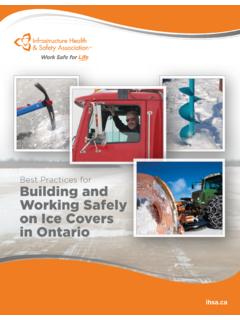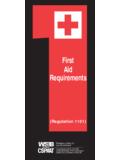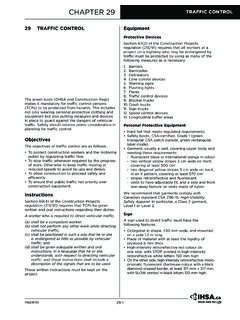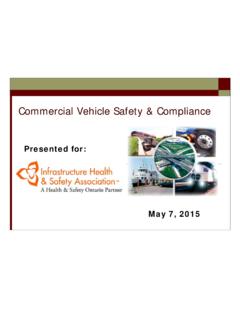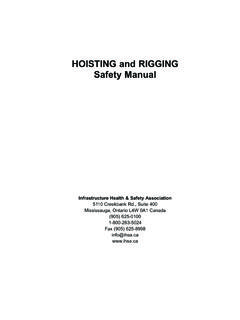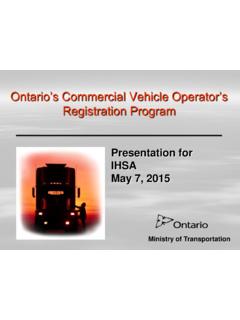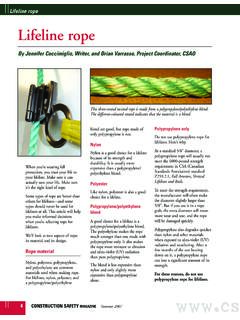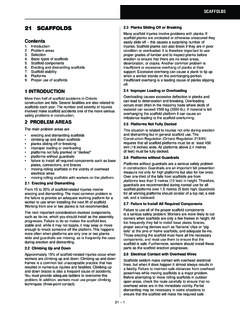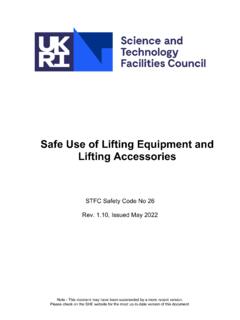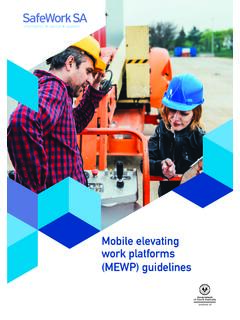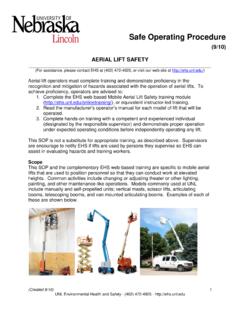Transcription of 22 MOBILE ELEVATING WORK PLATFORMS - IHSA
1 CHAPTER 22 MOBILE ELEVATING work PLATFORMS . 22 MOBILE ELEVATING work . PLATFORMS . Basic Types There are two basic types of MOBILE ELEVATING work PLATFORMS (MEWPs): 1. Scissor 2. Boom. Both types share three major components: Figure 22-1: Scissor-Type Powered PLATFORMS 1. Base Scissor-type machines must be set up on stable 2. Lifting mechanism level ground, even with outriggers deployed. A. 3. platform assembly. slight imbalance or instability is amplified when the machine is raised. Both types come in: On-slab models for use on smooth hard surfaces Figure 22-2 shows an example of controls. Although such as concrete or pavement fixed to the platform , the controls are moveable from -- Not designed for uneven or sloping ground one side of the platform to the other.
2 This enables the operator to see the path of travel. -- Normally have solid rubber tires -- Generally powered by rechargeable DC battery -- Some powered by internal combustion engine, either gasoline or propane -- Most have "pothole protection" a metal plate lowered close to the ground to afford some protection against inadvertent movement into depressions or debris. Rough-terrain models for use on firm level surfaces such as graded and compacted soil or gravel. -- Similar in design to on-slab machines -- Built to handle rigorous off-slab challenges -- Normally have wider wheel bases, larger wheels, and pneumatic tires -- Some fitted with outriggers for extra stability -- Usually powered by internal combustion engines, gasoline, diesel, or propane -- DC units also available but not common -- Lifting mechanism is hydraulic.
3 Scissor-Type Machines These are raised and lowered by hydraulic pistons and an expanding scissor mechanism. PLATFORMS are available in various configurations with different capabilities for extension and movement. Some Figure 22-2: Types of Controls have PLATFORMS that are extendable or that can on Scissor-Type PLATFORMS rotate. Extendable PLATFORMS should be retracted before raising or lowering the device. Typical Controls machines are illustrated in Figure 22-1. 1. Emergency stop 6. Drive high range/ low range Scissor-type machines range in capacity from 500 button switch to several thousand pounds and are available with 2. Choke 7. Forward/reverse joystick platform heights reaching 15 m (50 ft) or more. 3. Stop/start switch 8. Left/right steer switch 4.
4 Run/idle switch 9. Traversing deck out/in switch 5. Lift up/down switch 10. Outriggers up/down switch Equipment 22-1. MOBILE ELEVATING work PLATFORMS . The controls must be oriented correctly so that the As with MOBILE cranes, stability decreases with operator does not inadvertently move the machine length of boom and boom angle as the centre of in the wrong direction. Many machines have colour- gravity moves in relation to the platform position. coded directional arrows on the chassis to aid the The machine will overturn if the centre of gravity operator in moving the machine. moves outside the machine's base. Machines come with load charts that show safe Self-Propelled Boom-Supported PLATFORMS operating configurations. Machines with booms long enough to cause overturning at low boom angles are Typical machines are illustrated in Figure 22-3.
5 Required to have radius-limiting interlocks to prevent Normally fitted with rough-terrain undercarriages operation in unstable configurations. Some smaller on-slab units The reach chart shown in Figure 22-5 indicates the safe operating configurations for a machine with 36 m PLATFORMS have lifting capacity of about 227 kg (120 ft) of reach operating on a level surface. (500 pounds) or two workers Lack capacity of scissor-type machines Usually powered by an internal combustion engine, gasoline, diesel, or propane. Figure 22-3: Boom-Type Powered PLATFORMS REACH IN FEET (METRES) FROM AXIS OF ROTATION. Booms Figure 22-5: Reach Chart for 36-m (120-ft) Machine Telescopic, articulating, or combination of both The reach diagram in Figure 22-6 shows the safe Raised and extended by hydraulic cylinders operating envelope for a 10-metre boom machine.
6 Can extend well beyond the wheelbase. Notice that the machine does not achieve its maximum height directly overhead. Nor does it Figure 22-4 shows one example of controls for achieve its maximum reach at ground level. a boom machine. Although controls are fixed in Users must be familiar with the operating range position, the operator may become disoriented of the individual make and model they are using. by machine rotation and must remain aware This knowledge is essential in order to position the of the direction of movement. Many machines machine correctly and reach the work location safely. have colour-coded directional arrows to help the operator move the machine in the right direction. platform HEIGHT IN METRES. Figure 22-6: Reach Chart for Figure 22-4: Types of Controls on Boom Machines 10-m (33-ft) Articulating Boom platform 22-2 Construction Health and Safety Manual MOBILE ELEVATING work PLATFORMS .
7 Non-Self-Propelled or Push-Arounds Factors to Consider Capacity Does the machine have the lifting As the name indicates, push-around powered capacity, the reach, and the height to complete the PLATFORMS are not self-propelled and must be task? transported from one location to another with an independent power source or manually in the case Surface conditions Are the surface conditions of the smaller devices (Figure 22-7). hard or soft, sloped or level? Will the ground have an effect on the type of machine selected? The machines are intended primarily for use on smooth, level, hard surfaces or on-slab conditions. platform size and configuration Do you need Some trailer-mounted units are available. a regular or extendable platform ? Is rotation required?
8 Are there space restrictions to Many of these devices can fold up to pass through consider? a standard door and can be transported by pick-up truck. As a result, they are suitable for maintenance Mobility Is a boom type better suited than a or renovation work . scissor lift to the task at hand? Material to be lifted Will the machine be able to lift the size and weight of material required for the job? Access Will the machine be able to travel around the workplace safely? Are there obstructions or depressions that will restrict the use of certain machines? Operator skill or training Are the people on site competent to operate the machine? Has the operator received propane training? work environment If the work is to be done indoors or in a poorly ventilated area, will an electrically powered machine be required?
9 Basic Hazards Figure 22-7: Push-around Powered PLATFORMS The following are some basic hazards. Push-Arounds Machine tipping or overturning Raising mechanism normally powered by gasoline Many factors cause instability sudden stops, or propane engine or by electric motors, either AC depressions, drop-offs, overreaching, overloading, or DC etc. Overturning and tipping result in many fatalities and injuries. Normally raised and lowered by hydraulic cylinders Overriding safety features platform capacities vary from 300 to 1000 pounds Do not disarm safety features such as the tilt or or more but are generally less than 500 pounds level warning and the deadman switch. They let As platform is raised, risk of overturning increases operators know when they are in a dangerous situation.
10 Overriding the deadman switch has Extra care required when operating at maximum resulted in a fatality; so has malfunction of the tilt height. warning. Overhead powerlines Selection Working near overhead wires can result in MOBILE ELEVATING work PLATFORMS are designed for electrocution. This can happen when using any different uses. It is essential to select the right type of machine. machine for the job. Makeshift extensions When the machine can't reach the working Typical Mistakes height desired, don't compensate by using Using an on-slab machine on rough terrain scaffold planks, ladders, blocks of wood, or other makeshift arrangements. Such practices lead to Using a unit undersized with respect to height, falls and machine instability. reach, and lifting capacity Overloading the platform Extending the platform with planks, ladders, or MEWPs that are overloaded or loaded unevenly other devices because the machine can't reach can become unstable and fail.
